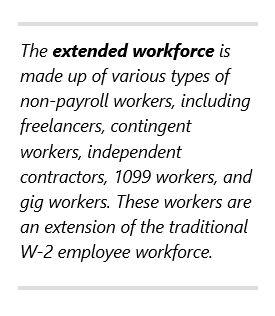Blog | 01 Nov 2020
Managing for the way we work now

Many American workers, both in traditional roles (e.g., W2 employees) and the extended workforce (e.g., non-payroll workers such as freelancers, independent contractors, and contingent workers), have seen vast changes driven by the COVID-19 pandemic. Suddenly, ways of working long familiar to contingent workers—remote, gig, and flexible work—have become commonplace.
Companies of all kinds are seeing the benefits of flexible work and offering permanent work-from-home opportunities (a move that could destigmatize remote work for all and open more doors for contingent workers). At the same time, freelance work has increased as unemployment claims soared and companies re-evaluated their budgets and staffing needs due to pandemic-related constraints.
 Yet reliance on freelancers and other non-payroll workers demands new approaches to management. Planning and oversight are increasing in complexity as jobs become more task- and project-oriented, and companies must deploy the right tools to manage this complexity, maximize productivity, and benefit from their investments in people. Effective and comprehensive workforce management is a priority for functions as diverse as finance, operations, and HR, which are responsible for defining the role that workers, including contingent workers, play for their companies.
Yet reliance on freelancers and other non-payroll workers demands new approaches to management. Planning and oversight are increasing in complexity as jobs become more task- and project-oriented, and companies must deploy the right tools to manage this complexity, maximize productivity, and benefit from their investments in people. Effective and comprehensive workforce management is a priority for functions as diverse as finance, operations, and HR, which are responsible for defining the role that workers, including contingent workers, play for their companies.
Further compounding the management challenge is the demand for work protections and social justice, which has intensified amidst the global pandemic, economic downturn, and looming uncertainty. Companies are paying attention to these demands: Uber, long criticized for its classification of drivers as independent contractors, says it is taking steps to improve conditions for their drivers. (The company’s plans will likely change in response to California’s ruling, which requires ride-share companies to classify their workers as employees.)
Non-payroll workers must be managed differently
Key to effective management is understanding the market for non-payroll workers, which is divided into submarkets such as services providers and software providers. The latter allows companies to directly source talent that might or might not be contracted by an agency, which raises a question for many executives: how should I deal with these contingent workers?
Many companies are finding value in doing this management themselves. Keeping oversight of non-payroll workers in-house can help companies reap benefits ranging from reduced risk and costs to increased visibility into their workforce.
Executives have many choices when it comes to the systems used to keep track of their contingent workers, but choosing between workforce management systems is not always easy (especially for small and midsize companies, which may lack the dedicated resources to make such decisions). Many companies do not fully account for important differences between the non-payroll submarkets, which can help define the best category of management software to choose—and there is no shortage of questions around best practices (starting with the fundamental choice between directly sourcing workers via a freelance management system versus relying on vendors for management in a vendor management system).
Taking the time to understand these differences and encourage transparency in management could substantially minimize risks to brand reputation. Lack of visibility into a company’s extended workforce can lead to rogue spending, compliance risk, and issues with the quality of outputs from given assignments. Effective management could also help integrate contingent workers into a company’s operations and culture—a struggle that both big and small companies experience and that could lead to issues down the line. (For example, two individuals who worked for Netflix sued the company, claiming they were misclassified as contractors and thus denied overtime payments, health insurance, and other benefits enjoyed by payroll employees.)
The most successful companies will be those that take the lead in redefining how the extended workforce is engaged—starting by understanding the composition of their own workforces and the details of their contingent workers’ tasks and contributions. As the nature of work continues to change and companies strategize to accommodate this ongoing transformation, executives will need to find ways to stay ahead of the curve. The pandemic and its many disruptions will pass, but the evolution of the workforce will continue.
Oxford Economics produced this blog as part of a broader program with WorkMarket, an ADP company.
Tags:
You may be interested in

Post
Amid disruption, what can US office learn from retail?
We examined the disruption of generative AI at the US county level. We identified several metros – Atlanta, Denver, New York, San Francisco, and Washington DC – that had at least one county with the highest percent of displaced workers from AI.
Find Out More
Post
Leading through the great disruption: How a human-centric approach to AI creates a talent advantage
The Oxford Economics' and Adecco Group’s Business Leaders research investigates the changing world of work from the executive perspective. Our research focuses on the impact on talent strategy of Artificial Intelligence (AI) and Generative AI (GenAI).
Find Out More
Post
Thriving beyond boundaries: Human performance in a boundaryless world
In collaboration with Deloitte, Oxford Economics surveyed 1,000 global executives and board leaders in order to understand their perspectives on emerging human capital issues.
Find Out More